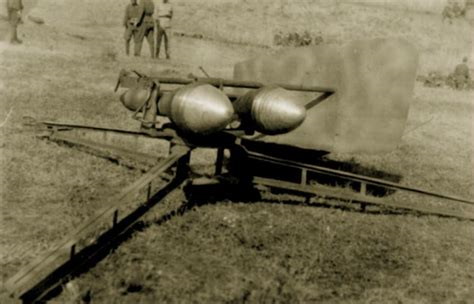
44M. Buzogányvető with the three-legged mount
The first 44M. Buzogányvető’s were mounted on a three-legged mount (or tripod), however with this solution, the Buzogányvető was a bit difficult to move. But, because of the lack of production capacity and time, the HTI didn’t construct new mobile platform/launcher for this weapon, they simply mounted the two rockets and the protection shield on the captured Soviet PM M1910 (Soviet-made Maxim) or SG-43 Goryunov machine guns’ wheeled mount, because the Hungarian Army captured plenty of them during the war.
The unguided ‘Buzogány’ HEAT rocket
44M. Buzogányvető on Krupp Protze truck
At the beginning of hostilities against the Soviets, the Hungarians sorely lacked sufficient anti-armour capability against the rugged and dependable T-34 tank. A large proportion of their weapons were supplied by Germany, but the Germans were not willing to share all their developments, particularly as the war stretched on and the logistical enormity of the war effort on the Eastern Front threatened to overwhelm them. Thus the Hungarians began research and development of their own anti-tank weaponry in 1942.
The Hungarian 44M “Buzogányvető” (translated most closely as “mace thrower” was a Hungarian designed experimental anti-tank rocket for use against Soviet armour towards the end of World War Two. The system allowed for two types of warhead, allowing a multi-purpose role to make it just as effective against enemy infantry. It is since regarded as one of the most effective anti-tank platforms of the War, despite its relatively short production run. The weapons were produced from Spring 1944 until December 20th 1944, when the WM factory fell to the Soviets. Between 600 and 700 were produced in total – the majority utilised in the Defence of Budapest in late December 1944.
The weapon consisted of a launcher capable of holding two rockets with shaped charge rounds, operated by a three-man crew. A tripod-based mount proved inefficient and captured Soviet wheeled mounts were often incorporated into the operational units. The weapons operational parameters made it ideally suited to the close-knit urban warfare of the Siege of Budapest
Two types of rocket were produced, the first was an anti-tank warhead known as ‘Buzogány’ (mace) from which the weapon derived its name. This carried 4.2kg of explosive and was more than capable of tearing through 300mm of armour – more than sufficient for any Soviet heavy tank at an effective range of 1200m. The second warhead was known as ‘Zápor’ (rainfall, shower), and was used in an anti-personnel capacity.